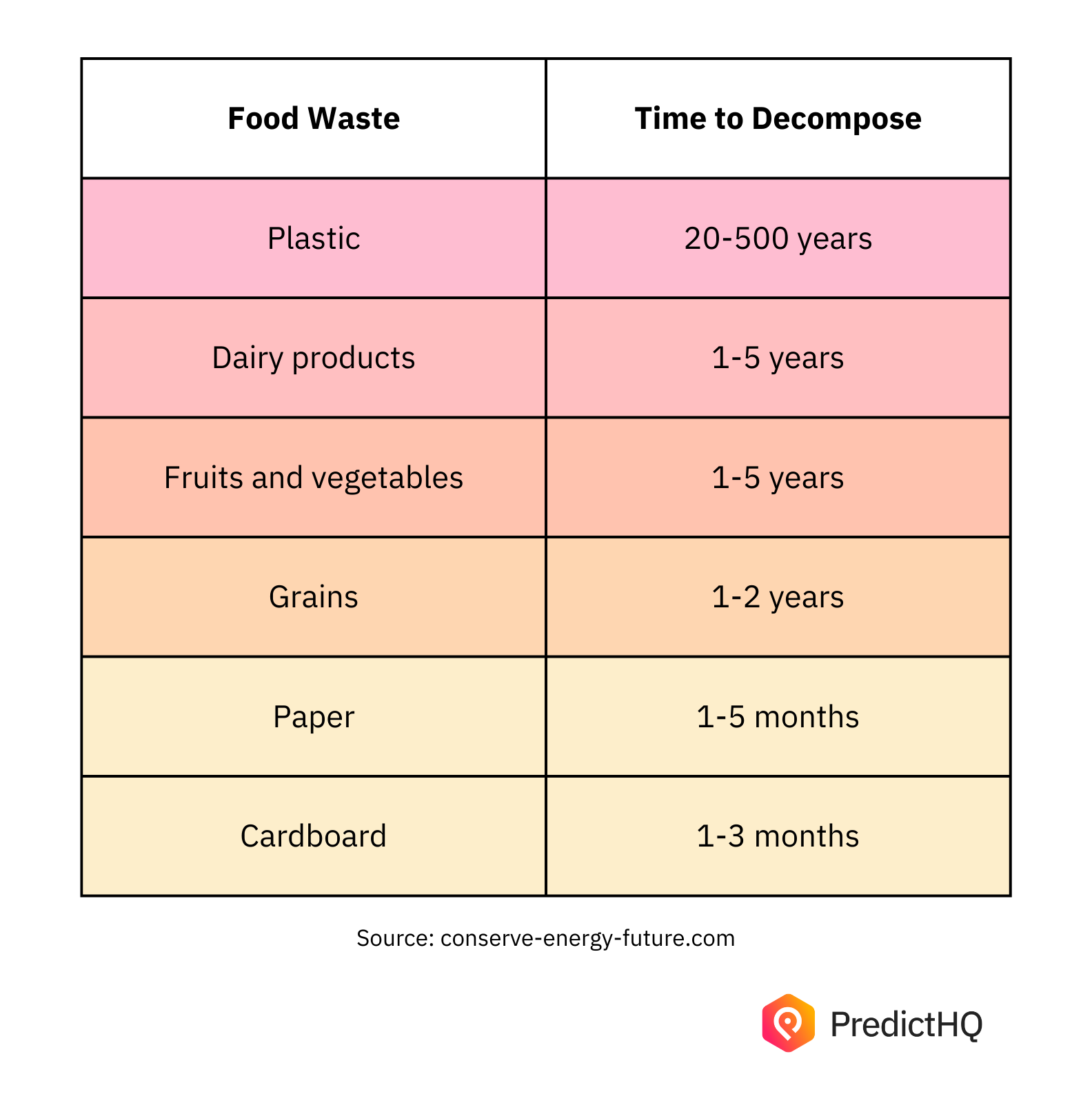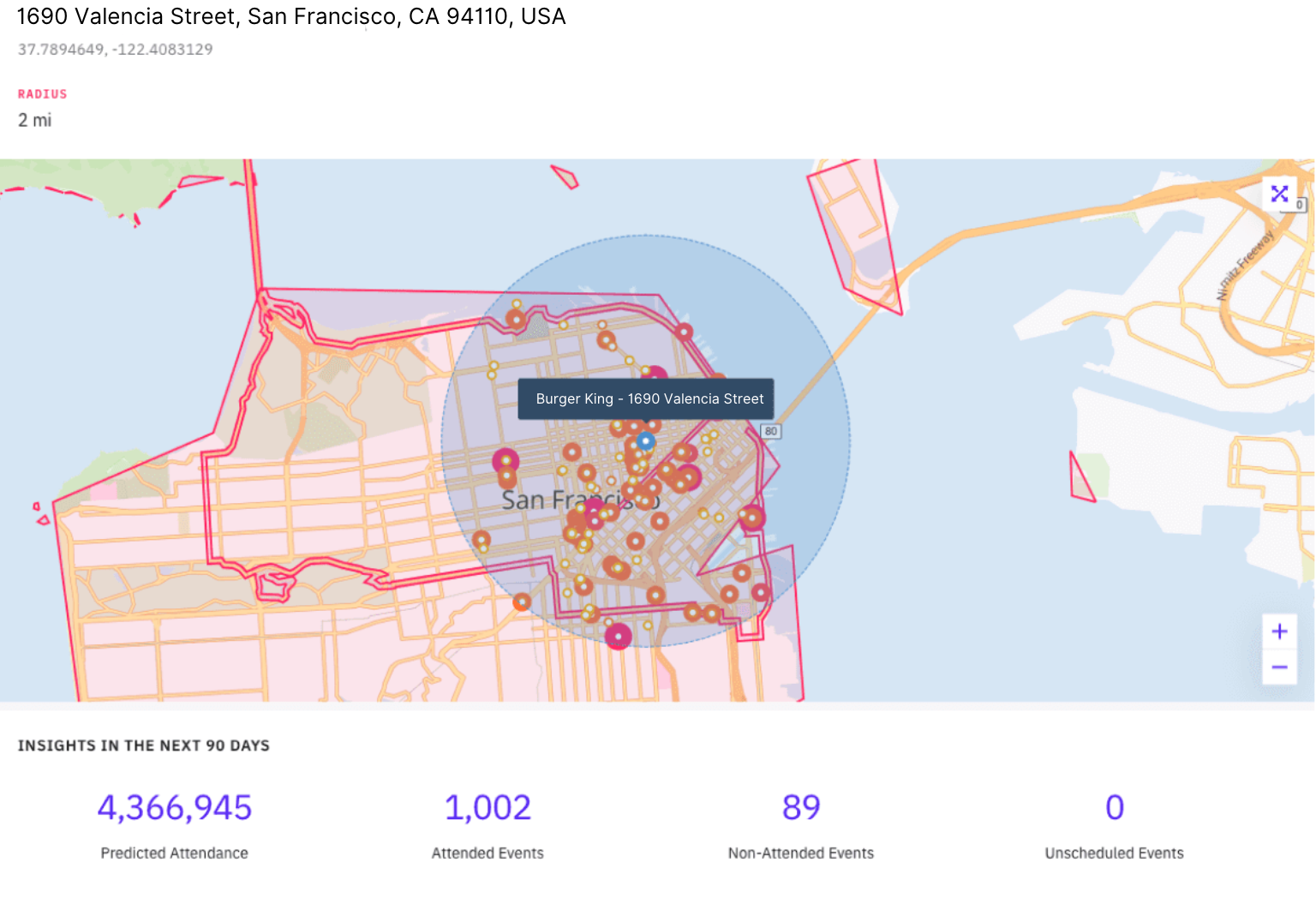Prevent food waste at scale with intelligent event data

US restaurants generate 27M tons of food waste each year
According to Restaurant Hospitality, the restaurant industry spends $25 billion every year on wasted food and overstocks as a result of inaccurate forecasts and poor foot traffic predictions. Besides costing the industry billions each year, once packaging, single-use plastics, and unused food items from these restaurants go in the trash, the waste takes years to break down in landfills:

As food waste decomposes in landfills, it releases methane, contributing to greenhouse gas emissions. The waste is also harmful because producing food uses resources such as land, abundant water, and more, which we can avoid wasting.
One way leading restaurants are reducing food waste is with the use of intelligent event data. The data is used to not only increase visibility into upcoming impactful events such as concerts and sports games, where they can better prepare in advance – but it is also used to analyze historical event data to determine which types of events have historically driven demand for different restaurant locations in the past.
The key to reducing food waste is tighter inventory control, which leading restaurants are achieving with the use of intelligent event data. The data includes 19+ types of events, such as festivals, sports, televised events (that can impact delivery demand), severe weather, holidays, and more. With deeper insights into demand-driving events within close proximity to their business locations, restaurant operators are aligning inventory levels with incoming levels of demand to prevent excess food inventory and food waste.
But you don't need to be an industry leader, or even have a dedicated data team to start using the same strategy for your restaurants. Read on to discover how to use events to reduce your impact on the environment, save money, and improve your brand’s reputation, all in four simple steps.
4 steps to preventing food waste at scale with intelligent event data
1. Pinpoint how different events impact your demand
The first step to reducing food waste is gaining a better understanding of the types of events that impact your specific business. By combining your historical sales data with years of historical event data, you will be able to quickly reveal the correlation between your demand and real-world events. This provides invaluable insight into the categories of events that most impact demand.
For example, store locations for one national fast food chain saw an almost 90% increase of in-store demand on Super Bowl Sunday, while another leader in the fast-casual space saw the exact opposite with a 30% drop of in-store demand – despite being in the same exact New Jersey neighborhood.
Sure, you may have a pulse on the impact of Super Bowl Sunday to your restaurants locations, but how about from the millions of other demand-impacting events that happen annually? Event correlation pinpoints how various categories of events have historically driven demand for your different restaurants. Share your anonymized demand data in a secure environment, and receive your detailed analysis today.
2. Accurately predict incoming levels of demand
Many restaurants use same day, last year, or a simple rolling average to forecast future sales. This method only gets you so far given the frequent peaks and valleys that occur in a given week.
Once the relationship is identified between your demand and certain event categories, you can start using events as a part of your planning. For many restaurants, inventory planning occurs on a monthly basis, so it’s important to incorporate event data directly via APIs to inventory forecasting models. For example, a leading national fast-casual restaurant chain is using our intelligent event data API to improve the accuracy of of their demand forecast to achieve the following:
Estimated revenue improvement: $2.1M
Supply chain gains from improving over and under forecasting: $2.7M
Staffing optimization gains: $2.6M
Total annual benefits: $7.5M
Built for scale, speed and accuracy, our API can be plugged into any forecasting platform or model to provide context about your demand.
There are other restaurants who need insight into demand changes caused by events. They may be making inventory choices on a weekly or bi-weekly basis and can easily train staff or regional managers to search for events the week of in our web UI. Depending on your planning methods, access to technical resources and more, there are many different ways to consume intelligent event data.
3. Adjust inventory levels as needed to prevent food waste
Event data doesn’t only show you when demand is predicted to be higher than usual – it is also used to alert restaurant operators in advance of expected slower periods that can be caused by a variety of events including unscheduled events such as severe weather, disasters, airport delays or big ticketed events like a sports game that might be drawing people to a different part of town than where your restaurant is located.
With visibility into events driving demand up and down for their restaurants, operators are equipped with the actionable insights they need to quickly update forecasts and plans to match what’s happening on the ground. This includes:
Redirecting inventory likely to go to waste to restaurant locations that won’t be impacted
Decreasing order sizes and postponing shipments
Ensuring appropriate safety plans are in place for impacted store locations
Having access to detailed event insights helps leading restaurants and QSRs avoid overordering and wasting food, saving millions per year in preventable wastage.
4. Track events impacting demand at the restaurant level
Once you’ve pinpointed the event categories that matter most to your business, predicted incoming demand fluctuations, and taken action to prepare for it – you can repeat this process across your restaurant locations to scale up the savings.
Track what’s happening around each and every one of your restaurant locations in seconds, so you and your team at large can stay informed, and prepared for changes in demand for each location.

With insight into predicted event spend, predicted attendance, event ranking, and more for events near each of your restaurants, you can determine the expected level of demand and prepare in advance to avoid excess inventory and food waste due to spoilage.
Join the ranks of leading restaurants using event data to improve sustainability
By taking steps to reduce food waste, restaurants are reducing their impact on the environment and creating a more sustainable food system. By prioritizing sustainability along with their other operational goals, these companies are not only reducing food waste – they’re also saving money, improving their reputation, and complying with environmental regulations.






